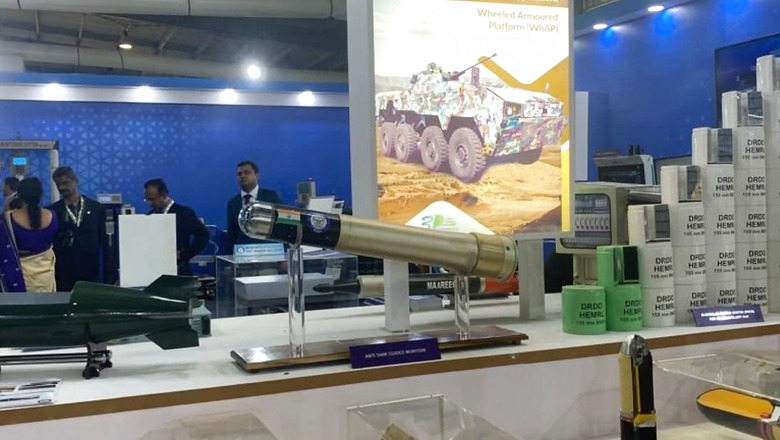
views
The DefExpo-2022 — India’s largest defence exhibition held in Gujarat’s Gandhinagar last week — brought to the fore an impressive number of Indian companies showcasing their offerings spanning new technology as well as modern platforms and equipment in use with the defence services.
The massive event saw 1,340 Indian companies, comprising private and state-owned, established and startups, participated in the 12th edition of the defence ministry’s biennial event.
This edition of the exhibition was open to participation from either purely Indian companies, Indian subsidiaries of foreign original equipment manufacturers (OEMs), divisions of companies registered in India or those foreign firms having joint ventures with Indian companies.
DefExpo-2022 underlined the twin ambitions of India in the defence sector—one is to be self-sustaining by full indigenisation of the defence equipment, platforms and weapon systems and new technologies sought by the country’s defence forces, and the other is to ramp up defence exports to reach a target goal of $5billion by 2025, starting with countries in Africa and the Indian Ocean Region.
Despite their offerings and promises, a few key policy-issues linger on, putting a hindrance to India realising its twin goals. I’ll make three points here.
Export Opportunities
Our reports from last week had highlighted the steps and timelines drawn out by Indian firms to meeting some of the critical requirements for the Indian Armed Forces.
For instance, Prime Minister Narendra Modi unveiled the Hindustan Aeronautics Limited (HAL)-manufactured HTT-40 basic trainer aircraft and is close to getting certification for the intermediate jet trainer. An order was placed with HAL for 70 HTT-40 for Rs 6,800 crore by the Indian Air Force.
Then there were BrahMos NG (next generation) supersonic cruise missiles developed by India and the Light Combat Aircraft Tejas Mk2 whose export potential is already being explored with several countries showing interest in it.
There is also the fifth generation Advanced Medium Combat Aircraft (AMCA) for the IAF and the Twin Engine Deck Based Fighter (TEDBF) for the Navy under development which when developed will fill up critical gaps in the number of fighter squadrons of the IAF and in the Navy.
A number of indigenous private firms—some of them iDEX winners—are developing a range of unmanned aerial vehicles among other new innovations in automation solutions as well as in upgrades for major defence platforms in use with the services. The services are also coming up with a range of innovations for the soldiers, as well as for export, such as the Navy’s combat management system.
Good Policies but No Implementation
To meet its twin objectives, the defence ministry has brought about several policy measures in the last few years, but there has been a little follow-up on some of critical ones, which directly affect defence exports and India’s self-reliance plans.
The much-touted strategic partnership model for the defence sector cleared by the Defence Acquisition Council in 2017, for instance, has failed to kick off in the last five years.
The policy, according to a government statement, was aimed at institutionalising a transparent, objective and functional mechanism to encourage broader participation of the private sector, in addition to defence PSUs in the manufacture of defence platforms and equipment such as aircraft, submarines, helicopters and armoured vehicles.
Aside from enhancing competition and increasing efficiencies, the idea was also to create an industrial ecosystem and ensuring development of a wider skill base, which would encourage innovation leading to bigger self-reliance.
Reports, however, say not even one project has taken off under this model in five years after the policy was cleared.
Even then, there lacks a clarity on what has been done so far to encourage private participation under this model which could lead to India developing an expertise in manufacturing complex platforms for other markets.
The second remains an effort to encourage and promote defence research in a bigger way, which may or may not yield immediate results, but is critical in the long run to develop niche technologies to enable India to tap the global defence market and stand out in it.
There have been some thoughts in the defence establishment towards this, as evident in finance minister Nirmala Sitharaman’s budget speech for 2022-23 in February this year, where she announced the opening up of defence research and development to the private industry, start-ups and academia and earmarking 25% of the defence R&D budget for the sector.
However, eight months down the line, this still lacks a roadmap or the modalities detailing how exactly the private sector would make use of this move to engage in adequate research.
With defence industrial corridors being set up in Uttar Pradesh and Tamil Nadu, and also the launch of the defence testing infrastructure scheme last year to boost domestic defence and aerospace manufacturing, it is important for the defence establishment to also latch on to the takeaways from the Centre’s National Logistics Policy released last month.
The policy aims to lower the cost of logistics from the existing 13-14% and bring it on a par with other developed countries.
Reducing logistics cost would bring down production expenses of defence equipment, weapon systems and platforms, which India aspires to manufacture indigenously—the factor that will help India clinch the deal with global customers.
Read all the Latest India News here











Comments
0 comment